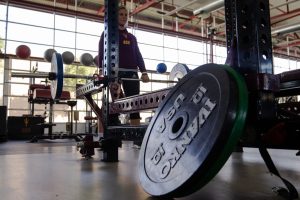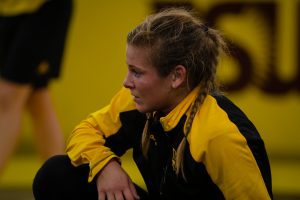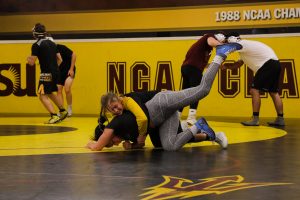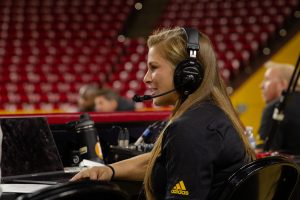- Slug: Sports-ASU female wrestler, about 1900 words.
- Photos attached below.
- Map: https://www.google.com/maps/d/viewer?mid=1rOXhYJA9A8B1K5RbL9khVQHa8smCICkg&usp=sharing
- Medal count: https://public.flourish.studio/visualisation/962927/?utm_source=showcase&utm_campaign=visualisation/962927
By Sarah Farrell
Cronkite News
TEMPE – Trailblazing must be in Marlee Smith’s DNA. One day, while cheering on her dad’s football team, the squad found itself a player short and an unexpected opportunity arose for the 8-year-old.
“He looked at me and he said, ‘I’m taking Marlee,’” her mom, Christie Smith, said. “He took her off the sideline, threw pads on her and put her on the football field.”
It didn’t end there. Marlee followed her male teammates to wrestling, a popular activity in her hometown of Wantage, New Jersey. She thrived in the sport, which led to a difficult choice many female wrestlers face after high school: choose a school where she could continue to wrestle other women or try to join a men’s roster at a school that offered the major she wanted?
About 21,000 students participate in women’s wrestling, according to a 2018-19 participation survey by the National Federation of State High School Associations. That’s up 5,000 from the previous year. Additionally, 18 states now sanction women’s wrestling at the high school level, including Arizona and Smith’s home state of New Jersey.
Historically, there have been two primary paths for women to continue in the sport beyond high school. They could attend a university with a women’s wrestling program, or they could try to claim one of the few resident-athlete spots at the U.S. Olympic Training Center (OTC) in Colorado Springs, Colorado.
They aren’t the only options, but making a men’s roster is a feat that few female wrestlers have accomplished.
Smith had to pick a path.
The journey to Arizona State
From the start, Smith had a connection with wrestling.
“She went in the room, and she fell in love with it,” her mom said.
The friendships she made and connection with her teammates drew her to the sport. That, and beating up on the boys, Smith said.
At the time Smith wrestled there, there weren’t a lot of girls competing. She was on the boys wrestling squad at High Point High School. According to her mom, Smith was one of only four or five girls competing in wrestling in New Jersey at the time.
“She was always the only girl in the youth program,” Christie Smith said. “She was the only girl at High Point High School when she wrestled from freshman to junior year. She would go to tournaments, and she’d be the only girl at a tournament.”
That changed after her junior year, though, when the multi-sport athlete decided to drop out of other sports such as soccer and field hockey to focus on the mat.
For her senior season, she transferred to Wyoming Seminary, a boarding school in Parkston, Pennsylvania, because the school had a girls wrestling team. It was the first time Smith competed on a girls’ team and only against female wrestlers.
For Smith, there wasn’t a big difference between being on a men’s team and being on a women’s team, though. Both “felt like family to me,” she said.
What made Seminary unique was the experienced coaches, Erin Vandiver and Adeline Gray, and the talent level of her teammates.
“Some of the best girls in the nation were there with me,” she said. “So, I was getting really good training there.”
As she neared the end of high school competition, Smith knew she needed to make a decision. She could go the traditional route and accept a scholarship to compete collegiately in women’s wrestling. Or she could once again step off the beaten path, move across the country and gain access to the coaches and training partners that Arizona State’s program had to offer.
Luckily, Smith had other female wrestlers who laid the path to ASU and served as role models. About a decade earlier, Kelsey Campbell first set foot in the ASU wrestling room, even though she didn’t come to the desert specifically to wrestle.
“The reason I moved to Arizona in the first place was to help build a college ministry for the church I was a part of,” Campbell said. “I was an ASU student, and I was training at pretty much wherever I could find when I moved here.”
In 2006, she took the unprecedented step of trying out for the men’s team at ASU.
“At the time, I was kind of struggling with structure from a scholastic standpoint and a wrestling standpoint,” Campbell said. “I felt like, ‘If I try out for the team, I have nothing to lose.’ ”
Campbell became the first female wrestler to walk-on at ASU, setting the example for younger wrestlers such as Smith.
But Campbell cautioned that this isn’t the best path for every young wrestler.
“It really depends on the athlete,” she said. “It depends on what your goals are. It depends on what you want your season to look like. It you want five to seven matches every week, then this is probably not the place for you. But if you want that extremely elite experience, being part of a Division I program, we do have some of the best coaches in the world here.”
The changing landscape of collegiate wrestling
Since the 2007-08 season, the Women’s Collegiate Wrestling Association (WCWA) has served as the oversight committee for women’s wrestling. It encompassed schools from the NAIA, NCAA and NJCAA that wanted to field a women’s wrestling program and compete for a collegiate national championship.
The NAIA began to shift the landscape of collegiate women’s wrestling when it granted the sport invitational status in 2018. The sport is not solidified as a championship sport yet, but many schools competed at the inaugural NAIA Women’s Wrestling National Invitational.
After an initial application was submitted in 2017, the NCAA announced this summer that it would add women’s wrestling, along with acrobatics and tumbling, to the NCAA Emerging Sports for Women program. Women’s wrestling could be contested as an emerging sport as early as Aug. 1, 2020. The sport reached the NCAA’s threshold of at least 20 varsity programs in 2019.
According to USA Wrestling and Wrestle like a Girl, there are currently 23 NCAA schools sponsoring women’s wrestling. To become a championship sport, there must be at least 40 programs at the Division 1 and 2 levels, combined.
Additionally, female wrestlers have the option to wrestle at the club level for teams in the National Collegiate Wrestling Association (NWCA).
Sarah Hildebrandt, a member of the US World Team, chose the collegiate wrestling path. She competed for King University, in Bristol, Tennessee, from 2012-2015, winning two national championships along the way.
“When I was in school, there weren’t a ton of choices, which meant it was possible for a lot of really talented women to all end up on the same team,” Hildebrandt said.
Being on a team with other talented, driven female wrestlers was a positive for Hildebrandt. It sparked an Olympic journey from the time she was a freshman.
“Even to this day, half of our Senior World Team is all King graduates,” Hildebrandt said. “To get to train every day with women who were so impressive was absolutely rad and great for my improvement. It was an intense practice room that I don’t think any other college matched at the time.”
Many of the universities that have women’s teams are small, with only a couple thousand students enrolled, and located in rural areas of the country. That limits the quality of facilities and coaches to which wrestlers have access. It also limits the academic degree options.
Near the end of her high school career, Smith had a number of offers to compete for schools in the WCWA.
“At tournaments, a lot of coaches came up to me, asking me to come visit their schools,” she said. “So I looked up wrestling schools and I didn’t like where they were located. They’re just in the middle of nowhere; small. Some didn’t have my major.”
Smith wanted to major in Family and Human Development and continue wrestling, so she knew she needed to find another option, which led to ASU.
About a decade ago, the only other option available to graduating female high school wrestlers was to apply for a spot as a resident athlete at the OTC. That requires an athlete to move to Colorado Springs, live at the OTC full time, work with the coaches there and dedicate most of her time to training.
The atmosphere, especially during an Olympic year, is incredibly tense, said Hildebrant, who became a resident athlete at the OTC after she left King.
“The OTC is the best thing that has ever happened to me,” she said. “I have access to everything it takes to be the best athlete I can be.”
Hildebrandt, Campbell and Gray, a five-time world champion and one of Smith’s coaches at Seminary, all spent time at the OTC.
Campbell trained at the OTC for 4 1/2 years after she left ASU. She had been beaten out at the World Team Trials in 2009, and realized she needed to make changes in her training.
“I had gotten out of it what I could get out of it at that point in my career,” Campbell said of her time at ASU. “It was time to transition and train around the best females in the world. If I was really serious about being the best in the world, that was where I needed to go.”
Growth of Regional Training Centers
Within the past decade, a shift has begun within American wrestling. Regional Training Centers (RTCs), often located near Division I programs, offer an elite training experience that is overseen and sanctioned by USA Wrestling.
“The RTCs have been fantastic for developmental wrestling in the United States,” said ASU wrestling coach Zeke Jones. “They’ve also been fantastic for women’s wrestling. (Female wrestlers) can train anywhere in the country that has a regional training center, and that’s mostly our best collegiate programs. So it gives our women a vehicle to train with the elite college athletes with aspirations of being the best in the world.”
Training at RTCs affords women access to experienced coaches such as Jones, an Olympic silver medalist who coached the 2012 U.S. Olympic freestyle wrestling team and who remains active with Team USA’s program. RTCs also offer mentors such as Campbell, a 2012 Olympian, along with world-class facilities.
For Smith, the decision to train at ASU was easy.
“I wanted to train with elite athletes and have some of the best coaches, and I knew this was the place to be,” Smith said.
Campbell has met a lot of younger wrestlers, but meeting Smith stood out.
“She was not just like ‘Oh, she wrestles, and she wants to join the team,’ ” Campbell said. “ (Smith) wanted to do something big. We just naturally clicked and became friends after that.”
Since Smith arrived in Tempe, she has, in turn, become a role model for other young female wrestlers.
“A lot of girls have been messaging me about coming here,” she said. “They always tell me they look up to me, and want to come here and train with me.”
Like Smith, they’re trailblazers.









